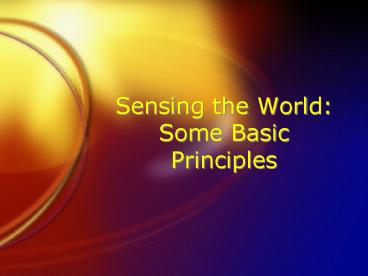Sensing the World: Some Basic Principles - PowerPoint PPT Presentation
1 / 21
Title:
Sensing the World: Some Basic Principles
Description:
Sensing the World: Some Basic Principles Describe what you see in the image below? Is this an example of bottom up or top-down processing. Answer: Example of Bottom ... – PowerPoint PPT presentation
Number of Views:119
Avg rating:3.0/5.0
Title: Sensing the World: Some Basic Principles
1
Sensing the World Some Basic Principles
2
Describe what you see in the image below? Is this
an example of bottom up or top-down processing.
3
Answer
- Example of Bottom up processing. You do not use
your experience to perceive an object. We use
only the the features of the object itself to
build a complete perception. We start our
perception at the bottom with the individual
characteristics and build up.
4
1) The title of the next image is rat-man. A)
Describe to me what you see in the image below.
B) Explain whether your ability to tell me what
you saw was an example of bottom up processing or
top down processing.
5
Answer
- This would be an example of top down processing
because you use your background knowledge to fill
in the gaps to what you perceive
6
3) Answer
- a. . The student would most likely overstimate
the amount of times he or she saw the signal
because the safety of the flight is in the
securities hand. In this simulation, nothing was
really at risk. This theory assumes that there
is no absolute threshold, and that the ability
for someone to detect a stimulus relies on
experience, expectations, motivation, and fatigue
7
4)Answer
- The difference threshold is the smallest amount
of change needed in a stimulus to detect change.
.5 is how much you can detect change. Webers
law states the more intense the stimulus the more
you will need to change to notice a difference.
It is harder to tell the difference between c and
b because they are more intense. You need more
change. An example would be putting hot sauce in
a non spicy soup and a spicy soup. You will need
to put more hot sauce on a spicy soup to tell the
difference
8
5) Answer
- Diminished sensitivity as a consequence of
constant simulation
9
What is the difference between top-down and
bottom up processing?
10
What is the difference between top down and
bottom up processing?
- Bottom up processing deals with simply using only
your sense receptors and then working up to a
higher level of processing. - Top down processing occurs by using prior
information, experience, or expectations to fill
in gaps
11
What is the difference between sensation and
perception?
12
What is the difference between sensation and
perception?
- Sensation is the pickup of information by our
sensory receptors, for example the eyes, ears,
skin, nostrils, and tongue.. Perception is the
interpretation of what is sensed.
13
What is the difference between absolute threshold
and difference threshold
14
- The minimum stimulation necessary to detect a
particular stimulus is the absolute threshold.
The difference threshold is the smallest amount
of change needed in a stimulus to detect change
15
What does research on signal detection theory
tell us?
16
- Signal Detection theorists have found out that
people respond differently to the same stimuli
under different circumstances. - Examples?
17
Are subliminal stimuli sensed? Are they
perceived?
18
- Yes if slightly below the absolute threshold it
can be sensed at times. Yes it can be perceived.
Example????
19
Briefly explain the process of sensory
adaptation. How does it focus our attention on
changing stimulation?
20
- Sensory adaptation occurs because our body
becomes less sensitive to an unchanging stimulus - Allows our body to focus less on other things
around us that are changing, rather than stimulus
that is constant
21
Examples of Sensory Adaptation
- Sight
- Hearing
- Taste
- Smell
- Touch































